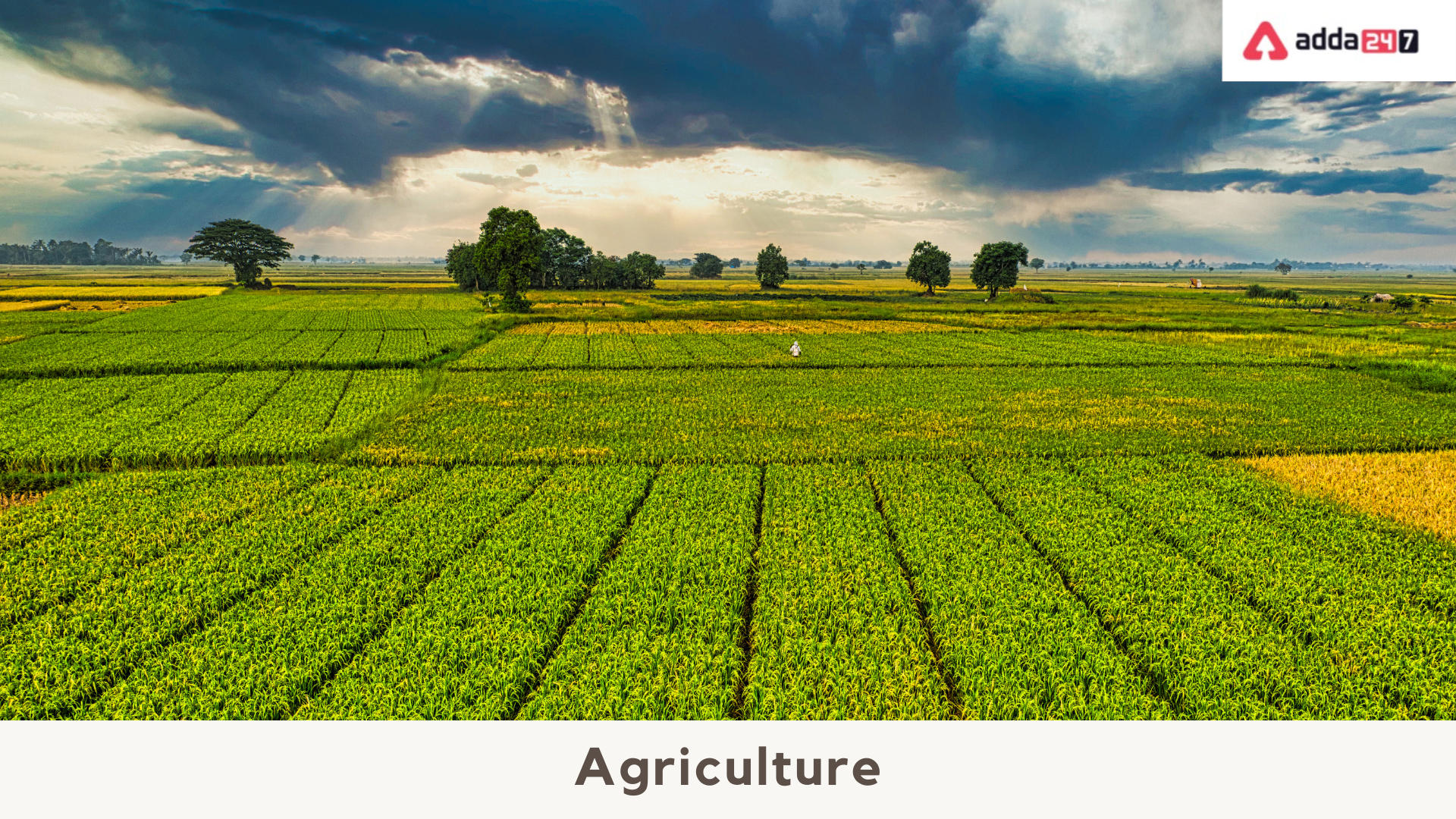Table of Contents
Agriculture Definition
Two-thirds of India’s population is engaged in agricultural activities. Agriculture is a primary activity, which produces most of the food raw material for various industries. In CBSE Notes Class 10 Geography Chapter 4 – Agriculture, you will study the various types of farming, cropping patterns and major crops grown in India. In the end, you will know how much Agriculture contributes to the National Economy, Employment and Output.
Class 10 Geography Chapter 4 Agriculture- Types of Farming
The cultivation methods depend upon the characteristics of the physical environment, technological know-how and socio-cultural practices. Farming varies from subsistence to commercial type. In different parts of India, the following farming systems are practised.
Primitive Subsistence Farming
It is a ‘slash and burn’ agriculture. Farmers clear a patch of land and produce cereals and other food crops. When the soil fertility decreases, the farmers shift and clear a fresh patch of land for cultivation. It is known by different names in different parts of the country. It is known as jhumming in north-eastern states.
- Land productivity is low in this type of agriculture.
- This type of farming depends on the monsoon.
- This farming is practised in a few parts of India.
Intensive Subsistence Farming
- This type of farming is practised in areas of high population pressure on land.
- It is labour-intensive farming, where high doses of biochemical inputs and irrigation are used for higher production.
Class 10 Geography Chapter 4 Agriculture- Commercial Farming
This type of farming uses higher doses of modern inputs such as high yielding variety (HYV) seeds, chemical fertilisers, insecticides and pesticides to obtain higher productivity.
Plantation is a type of commercial farming in which a single crop is grown on a large area. Plantations cover large tracts of land, using capital intensive inputs, with the help of migrant labourers. All the produce is used as a raw material in industries.
Eg: Tea, Coffee, Rubber, Sugarcane, Banana.
Class 10 Geography Chapter 4 Agriculture- Cropping Pattern in India
India has three cropping seasons:
- Rabi
- Kharif
- Zaid
| Rabi | Kharif | Zaid | |
| Sowing Season | Winter from October to December | Beginning of the rainy season between April and May | In between the Rabi and the Kharif seasons, there is a short season during the summer months known as the Zaid season (in the months of March to July) |
| Harvesting Season | Summer from
April to June |
September-October | |
| Important Crops | Wheat, Barley, Peas, Gram and Mustard. | Paddy, Maize, Jowar, Bajra, Tur (Arhar),
Moong, Urad, Cotton, Jute, Groundnut and Soyabean. |
Watermelon, Muskmelon, Cucumber,
Vegetables and Fodder crops |
Class 10 Geography Chapter 4 Agriculture- Major Crops in India
A variety of food and non-food crops are grown in different parts of India, depending upon the variations in soil, climate and cultivation practices. Major crops grown in India are:
- Rice
- Wheat
- Millets
- Pulses
- Tea
- Coffee
- Sugarcane
- oil seeds
- Cotton
- Jute
Rice
- It is a kharif crop.
- It requires high temperature and high humidity with annual rainfall above 100 cm.
- India is the second largest producer of rice in the world after China.
- It is grown in the plains of north and north-eastern India, coastal areas and the deltaic regions.
Wheat
- This is a rabi crop.
- It requires a cool growing season and bright sunshine at the time of ripening.
- It requires 50 to 75 cm of annual rainfall evenly distributed over the growing season.
- The Ganga-Satluj plains in the north-west and black soil region of the Deccan are two main wheat-growing zones in India.
- It is the second most important cereal crop and main food crop, in the north and north-western part of India.
Millets
- Jowar, Bajra and Ragi are the important millets grown in India.
- These are known as coarse grains and have very high nutritional value.
| Jowar | Bajra | Ragi |
| 3rd most important food crop with respect to area and production. | Grows well on sandy soils and shallow black soil. | It is a crop of dry regions. |
| It is a rain-fed crop mostly grown in the moist areas. | Grows well on red, black, sandy, loamy and shallow black soils. | |
| Mainly produced in Maharashtra, Karnataka, Andhra Pradesh and Madhya Pradesh. | Major producing states are Rajasthan, Uttar Pradesh, Maharashtra, Gujarat and Haryana. | Major producing states are Karnataka, Tamil Nadu, Himachal Pradesh, Uttarakhand, Sikkim, Jharkhand and Arunachal Pradesh. |
Maize
- It is a Kharif crop.
- It requires a temperature between 21°C to 27°C and grows well in old alluvial soil.
- It is used both as food and fodder.
- Major maize-producing states are Karnataka, Madhya Pradesh, Uttar Pradesh, Bihar, Andhra Pradesh and Telangana.
Pulses
- India is the largest producer and consumer of pulses in the world.
- Pulses are the major source of protein in a vegetarian diet.
- Major pulses grown in India are Tur (Arhar), Urad, Moong, Masur, Peas and Gram.
- Pulses are mostly grown in rotation with other crops so that the soil restores fertility.
- Major pulse producing states are Madhya Pradesh, Rajasthan, Maharashtra, Uttar Pradesh and Karnataka.
Class 10 students can now join the board exam preparation batch by Adda247 and ace their board exam.
Class 10 Geography Chapter 4 Agriculture- Food Crops other than Grains
Sugarcane
- It is a tropical as well as a subtropical crop.
- It grows well in hot and humid climates with a temperature of 21°C to 27°C and annual rainfall between 75cm to 100cm.
- It can be grown on a variety of soils.
- Needs manual labor from sowing to harvesting.
- India is the second largest producer of sugarcane only after Brazil.
- Sugarcane is the main source of Sugar, Gur (Jaggery), Khansari and molasses.
- The major sugarcane-producing states are Uttar Pradesh, Maharashtra, Karnataka, Tamil Nadu, Andhra Pradesh, Telangana, Bihar, Punjab and Haryana.
Oil Seeds
Different oil seeds are grown covering approximately 12% of the total cropped area of India. Main oil-seeds produced in India are:
- Groundnut: is a Kharif crop and accounts for half of the major oilseeds produced in India. Gujarat is the largest producer of groundnuts.
- Mustard: is a rabi crop.
- Sesamum (til): is a Kharif crop in the north and rabi crop in south India.
- Castor seeds: It is grown as both Rabi and Kharif crop.
- Linseed: is a rabi crop.
- Coconut
- Soyabean
- Cotton seeds
- Sunflower
Tea
- It is also an important beverage crop introduced by the British in India.
- The tea plant grows well in tropical and sub-tropical climates with deep and fertile well-drained soil, rich in humus and organic matter.
- Tea bushes require a warm and moist frost-free climate all through the year.
- Tea is a labour-intensive industry.
- Major tea producing states are Assam, hills of Darjeeling and Jalpaiguri districts, West Bengal, Tamil Nadu and Kerala.
Coffee
Yemen coffee is produced in India and this variety of coffee is in great demand all over the world. Its cultivation was introduced on the Baba Budan Hills and is confined to the Nilgiri in Karnataka, Kerala and Tamil Nadu.
Horticulture Crops
India is a producer of tropical as well as temperate fruits. Major crops produced are pea, cauliflower, onion, cabbage, tomato, brinjal and potato. Some of the famous horticulture crops grown in India are:
- Mangoes of Maharashtra, Andhra Pradesh, Telangana, Uttar Pradesh and West Bengal Oranges of Nagpur and Cherrapunjee (Meghalaya), bananas of Kerala, Mizoram, Maharashtra and Tamil Nadu.
- Lichi and Guava of Uttar Pradesh and Bihar
- Pineapples of Meghalaya
- Grapes of Andhra Pradesh, Telangana and Maharashtra
- Apples, pears, apricots and walnuts of Jammu and Kashmir and Himachal Pradesh
Class 10 Geography Chapter 4 Agriculture-Non-Food Crops
| Rubber | Fibre | Cotton | Jute |
| It is an equatorial crop. | Cotton, Jute, Hemp and Natural Silk are the four major fibre crops. | It is a Kharif crop. | It is known as the golden fibre. |
| It requires a moist and humid climate with rainfall of more than 200cm and temperature above 25°C. | Cotton, Jute and Hemp are grown in the soil. | It requires high
temperature, light rainfall, 210 frost-free days and bright sunshine for its growth. |
It grows well on well-drained fertile soils in the flood plains. High temperature is required for its growth. |
| It is an important industrial raw material | Natural Silk is obtained from cocoons of the silkworms fed on green leaves | Cotton grows
well in black cotton soil of the Deccan plateau. |
It is used in making gunny bags, mats, ropes, yarn, carpets and other artefacts. |
| Mainly grown in Kerala, Tamil Nadu, Karnataka and Andaman and Nicobar islands and Garo hills of Meghalaya. | Rearing of silkworms for the production of silk fibre is known as
Sericulture. |
Major cotton-producing states are Maharashtra, Gujarat, Madhya Pradesh, Karnataka, Andhra Pradesh,
Telangana, Tamil Nadu, Punjab, Haryana and Uttar Pradesh. |
Major jute producing states are West Bengal, Bihar, Assam, Odisha and Meghalaya. |
Class 10 Geography Chapter 4 Agriculture-Technological and Institutional Reforms
Agriculture provides a livelihood for more than 60% of its population, so this sector needs some serious technical and institutional reforms. The Green Revolution and the White Revolution were some of the reforms initiated by people to improve agriculture.
Some Initiatives taken by the Government are:
- Schemes introduced by the Government such as Kissan Credit Card (KCC), Personal Accident Insurance Scheme (PAIS).
- Special weather bulletins and agricultural programmes for farmers on the radio and television were introduced.
- The government also announces minimum support price, remunerative and procurement prices for important crops to check the exploitation of farmers by speculators and middlemen.
Contribution of Agriculture to the National Economy, Employment and Output
- In 2010-11 about 52% of the total workforce was employed by the farm sector.
- The share of agriculture in the GDP is declining.
- Indian Council of Agricultural Research (ICAR), agricultural universities, veterinary services and animal breeding centers, horticulture development, research and development in the field of meteorology and weather forecast, etc. are a few of the initiatives introduced by the government to improve Indian agriculture.
Class 10 Geography Chapter 4 Agriculture-Important Question and Answer
Question 1 Write four points to stress the importance of agriculture in India. (2013)
Or, Why is India called an agriculturally important country? Write four supportive arguments.
Or, ‘Agriculture has been the backbone of the Indian Economy’ Explain the statement by giving reason. (2017 D)
Ans. India is an agricultural country because of the following reasons:
- Two-third of its population is engaged in agricultural activities which provide livelihood.
- Agriculture is a primary activity and produces most of the food and foodgrains that we consume.
- It produces raw materials for our various industries, e.g., cotton textile and sugar industry.
- Some agricultural products, like tea, coffee and spices, are exported and earn foreign exchange.
- The share of agriculture in providing employment and livelihood to the population continued to be as high as 63% in 2001.
Question 2 Why do farming practices vary in different regions? Give three major reasons.
Ans. Three major reasons are:
- Physical environment, i.e., relief, soil and climate.
- Technological know-how.
- Socio-cultural practices.
Question 3 Name some industries based on agricultural raw material.
Ans. Cotton Textile Industry and Sugar Industry.
Question 4 What factors does primitive subsistence farming depend on?
Ans. Factors:
- Monsoons
- Natural fertility of the soil
- Suitability of other environmental conditions to the crops grown.
Question 5 Write main characteristics of ‘slash and burn’ agriculture.
Or, Write main characteristics of Primitive Subsistence Farming.
Ans.
- This type of farming is practised in few pockets of India on small patches of land using primitive tools and family/community labour.
- Farmers clear a patch of land and produce cereals and other food crops to sustain their families.
- When the soil fertility decreases, the farmers shift and clear a fresh patch of land for cultivation. This type of shifting allows nature to replenish the fertility of the soil through natural processes.
- Land productivity is low as the farmer does not use fertilisers or other modem inputs.
Question 6 Name some primitive tools used in ‘slash and bum’ agriculture.
Ans. Tools like hoe, dao and digging sticks.
Question 7 Compare ‘intensive subsistence farming’ with that of ‘commercial farming’ practiced in India.
Ans.
| Intensive Subsistence Farming | Commercial Farming |
| (i) In this type of farming, production is mainly for self consumption. | (i) In this, crops are mainly grown for commercial purposes. |
| (ii) It is practised in areas of high population pressure on land. | (ii) It is practiced on large pieces of land on scientific and commercial lines. |
| (iii) It is labour intensive farming. | (iii) In this type of agriculture, machines and modem technology are used. |
| (iv) In this, high doses of biochemical inputs and irrigation are used for obtaining higher production. | (iv) There is higher use of modern agricultural inputs, for example, High Yielding Variety (HYV) seeds, fertilisers, irrigation, etc. are used to obtain higher yields and production. |
| (v) Farmers take maximum output from the limited land by raising 2-3 crops in a year from the same land, i.e., multiple cropping is practised. | (v) The degree of commercialization varies from one region to another. Rice is a commercial crop in Punjab, while in Orissa it is subsistence crop. For example, Plantation agriculture. |
Question 8 Write the main characteristics of intensive subsistence farming.
Ans.
- It is practised in areas of high population pressure on land.
- It is labour intensive farming.
- Yield per hectare is high because high doses of biochemical inputs and irrigation are used.
- The size of the land-holdings is small and uneconomical.
- Farmers take maximum output from the limited land by raising 2-3 crops in a year from the same land, i.e., multiple cropping is practised.
Question 9 What are the major differences between primitive subsistence farming and commercial farming? (2013)
Ans.
| Primitive Subsistence Farming | Commercial Farming |
| 1. In this mainly cereals and other food crops are grown by farmers to sustain themselves. | 1. In this, crops are mainly grown for commercial purposes. |
| 2. It is generally done on small land holdings which are economically not viable. | 2. It is practiced on large pieces of land on scientific and commercial lines. |
| 3. Primitive tools and animals are used for carrying out agricultural activities. | 3. In this type of agriculture, machines and modern technology are used. |
| 4. In this, modern agricultural inputs, e.g., fertilisers and irrigation are not widely used. | 4. There is higher use of modern agricultural inputs, e.g., HYV seeds, fertilisers, irrigation, etc. are used to obtain higher yields and production. |
| 5. Subsistence Agriculture is called Jhumming in Assam, Mizoram; Kuruwa in Jharkhand.
E.g., Slash and Burn. |
5. The degree of commercialization varies from one region to another. Rice is a commercial crop in Punjab, while in Orissa it is a subsistence crop. E.g., Plantation agriculture. |
Question 10 What is the most important characteristic of commercial farming?
Ans. The main characteristic of commercial farming is the use of higher doses of modern inputs, e.g. high yielding varieties seeds (HYVs), chemical fertilizers and pesticides to increase productivity. The degree of commercialisation of agriculture varies from one region to another.
Found this article helpful?
Let’s connect via chat or call our senior expert counsellor at +91-9625869989 to learn more about the different streams and options available.
We would love it if we could add some of your insights. If you have a definite goal of scoring the highest marks, then you can resolve your doubts via our app/quizzes and youtube class assistance (https://www.youtube.com/c/Adda247School)
Class 10 Geography Chapter 4 Agriculture-
FAQs
Question 1 Why is Agriculture an important occupation?
Ans. Cultivation of crops and breeding of livestock is included in the agriculture occupation. Farmers play a crucial role in the development and progress of our country.
Question 2 Which are the best/most suitable seasons for Agriculture in india?
Ans. Each state depends on its own monsoon seasons. Monsoon rains are important for the growth and cultivation of crops.
Question 3 Which are the major crops grown in India?
Ans. Rice, wheat, millets, pulses, tea, coffee are some of the main crops in India.
Question 4 What are the 3 types of agriculture?
Ans. Subsistence agriculture is often divided into three different types, including intensive subsistence, which is the traditional method, shifting cultivation, which relies on clearing forest to create new farm plots every few years and pastoral nomadism, which relies on traveling with herds of animals
Question 5 What is the importance of agriculture?
Ans. Agriculture provides most of the world’s food and fabrics. Cotton, wool, and leather are all agricultural products. Agriculture also provides wood for construction and paper products. These products, as well as the agricultural methods used, may vary from one part of the world to another.
Question 6 What are the problems of agriculture?
Ans. These three challenges – feeding a growing population, providing a livelihood for farmers, and protecting the environment – must be tackled together if we are to make sustainable progress in any of them


 UHSR Result 2024 OUT, Download ANM, BSc ...
UHSR Result 2024 OUT, Download ANM, BSc ...
 Top 10 JNV in India 2024, Check Best Nav...
Top 10 JNV in India 2024, Check Best Nav...
 BU Bhopal Result 2024 OUT for 1st and 2n...
BU Bhopal Result 2024 OUT for 1st and 2n...





























